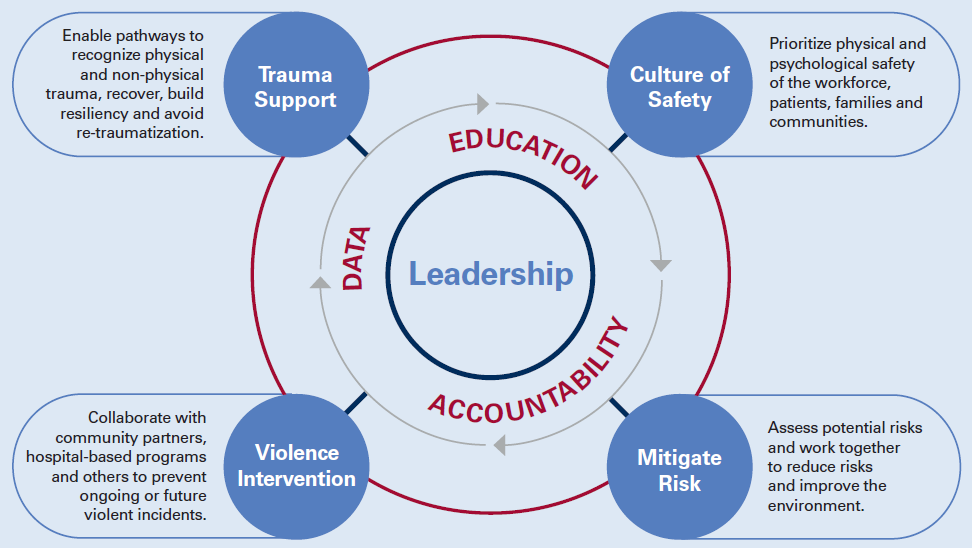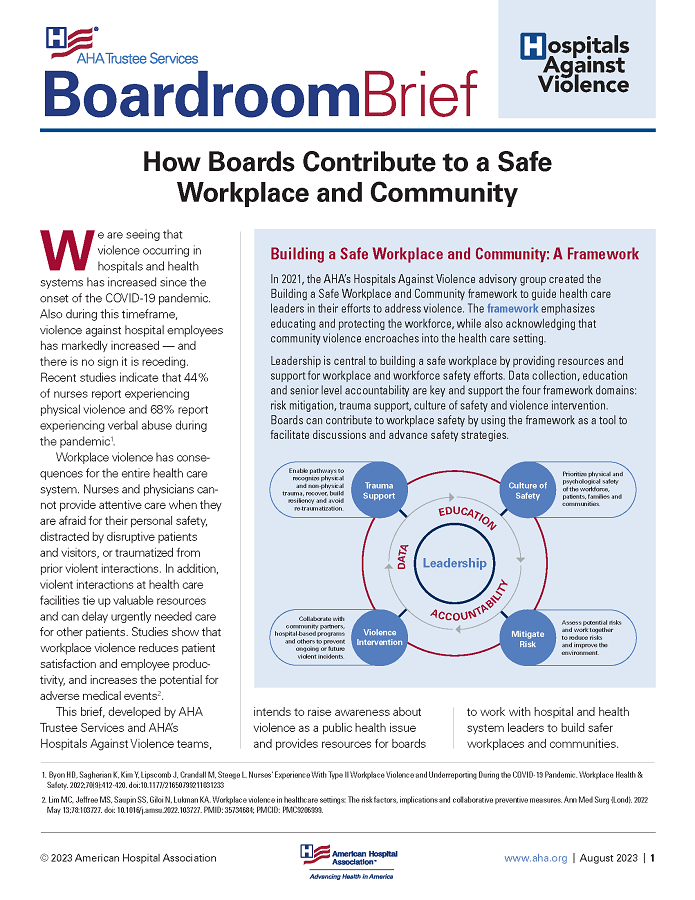Boardroom Brief: How Boards Contribute to a Safe Workplace and Community
We are seeing that violence occurring in hospitals and health systems has increased since the onset of the COVID-19 pandemic. Also during this timeframe, violence against hospital employees has markedly increased — and there is no sign it is receding. Recent studies indicate that 44% of nurses report experiencing physical violence and 68% report experiencing verbal abuse during the pandemic.1
Workplace violence has consequences for the entire health care system. Nurses and physicians cannot provide attentive care when they are afraid for their personal safety, distracted by disruptive patients and visitors, or traumatized from prior violent interactions. In addition, violent interactions at health care facilities tie up valuable resources and can delay urgently needed care for other patients. Studies show that workplace violence reduces patient satisfaction and employee productivity, and increases the potential for adverse medical events.2
This brief, developed by AHA Trustee Services and AHA’s Hospitals Against Violence teams, intends to raise awareness about violence as a public health issue and provides resources for boards to work with hospital and health system leaders to build safer workplaces and communities.
Building a Safe Workplace and Community: A Framework
In 2021, the AHA’s Hospitals Against Violence advisory group created the Building a Safe Workplace and Community framework to guide health care leaders in their efforts to address violence. The framework emphasizes educating and protecting the workforce, while also acknowledging that community violence encroaches into the health care setting.
Leadership is central to building a safe workplace by providing resources and support for workplace and workforce safety efforts. Data collection, education and senior level accountability are key and support the four framework domains: risk mitigation, trauma support, culture of safety and violence intervention. Boards can contribute to workplace safety by using the framework as a tool to facilitate discussions and advance safety strategies.

How Do Boards Get Involved?
Violence is a public health crisis that affects us all, and it takes a concerted effort from a broad coalition in every community to create safety. Governing boards have the opportunity to work with hospital and health system leadership, community stakeholders, local and state officials and patients to break the cycle of violence.
Boards are encouraged to ensure there is an organizational strategy to keep their hospital and health system free of violence. Awareness, commitment and action from executive management and the board communicates to the workforce that they are valued and that their safety is a priority.
Trustees can start by asking questions so they understand the organization’s plan to keep everyone safe, to prevent the next violent incident and to provide support to those traumatized by violence. The questions and resources below provide a starting point for boards to initiate important discussions about building a safer workplace and community through violence prevention efforts.
Questions for Trustees to Discuss Their Organization’s Violence Prevention Efforts
- Does your organization have a workplace violence prevention policy?
- Is the board receiving updates on programs and policies related to workplace violence prevention, including education, training and trauma support programs?
- Is your organization routinely reporting data on incidents of violence to leadership, including the board?
- Does the organization have a strategy and dashboard to assess workplace safety and is this shared with the board?
- If your Community Health Needs Assessment (CHNA) or community health initiative identifies violence as a priority, is the board receiving updates on programs and partnerships that aim to reduce community violence?
What the Board Can Do
On the regulatory front, The Joint Commission (TJC) expects a hospital board to address workplace violence and issued its Workplace Violence Prevention Standards for hospitals. The board should provide the appropriate level of oversight for these standards.
Those standards require:
- Annual worksite analysis of the hospitals’ prevention program and a record of the actions taken to mitigate or resolve workplace safety and security risks.
- A process for continually monitoring, reporting and investigating incidents involving patients and staff, occupational illnesses or injuries, and potential hazards such as fire, medical equipment and utility systems.
- Training, education and resources on the hospital’s workplace violence prevention program at the time of hire, annually or for staff changes. This includes education on the roles and responsibilities of leadership, clinical staff, security personnel and law enforcement as well as de-escalation training.
- A designated individual to lead the workplace violence prevention program developed by a multidisciplinary team that includes policies and processes to prevent and respond to workplace violence, support victims and report to the governing body.
TJC standards require that a hospital’s workplace violence program be led by a designated individual and that hospital leadership, including the Board, receive regular reports on incidents and trends.
AHA Resources:
- AHA’s Hospitals Against Violence: Workforce and Workplace Violence Prevention
- AHA’s Trustee Services
- Building a Safe Workplace and Community framework helps guide hospital and health system leadership to address the issues of violence in their workplace, with an emphasis on educating and protecting the workforce.
- Issue Brief: Mitigating the Risk of Violence
- AHA Strengthening the Health Care Workforce guide, helps hospitals navigate workforce challenges and opportunities, as well as highlight strategies and resources to assist on these important efforts.
- Creating Safer Workplaces: A guide to mitigating violence in health care settings. A collaboration between AHA and the International Association for Healthcare Security and Safety.
- Creating Safer Workplaces: Safety Strategies that Worked case study series
- Violence Prevention Programs – Infographic
Other Resources:
- American College of Healthcare Executives Healthcare Executives’ Role in Mitigating Workplace Violence; 2018. https://www.ache.org/about-ache/our-story/our-commitments/policy-statements/healthcare-executivesrole-in-mitigating-workplace-violence
- The Joint Commission. The essential role of leadership in developing a safety culture. Sentinel Event Alert. 2017;(57):1-8. https://www.jointcommission.org/resources/sentinel-event/sentinel-event-alert-newsletters/sentinel-eventalert-57-the-essential-role-of-leadership-in-developing-a-safety-culture
- Byon HD, Sagherian K, Kim Y, Lipscomb J, Crandall M, Steege L. Nurses’ Experience With Type II Workplace Violence and Underreporting During the COVID-19 Pandemic. Workplace Health & Safety. 2022;70(9):412-420. doi:10.1177/21650799211031233
- Lim MC, Jeffree MS, Saupin SS, Giloi N, Lukman KA. Workplace violence in healthcare settings: The risk factors, implications and collaborative preventive measures. Ann Med Surg (Lond). 2022 May 13;78:103727. doi: 10.1016/j.amsu.2022.103727. PMID: 35734684; PMCID: PMC9206999.

